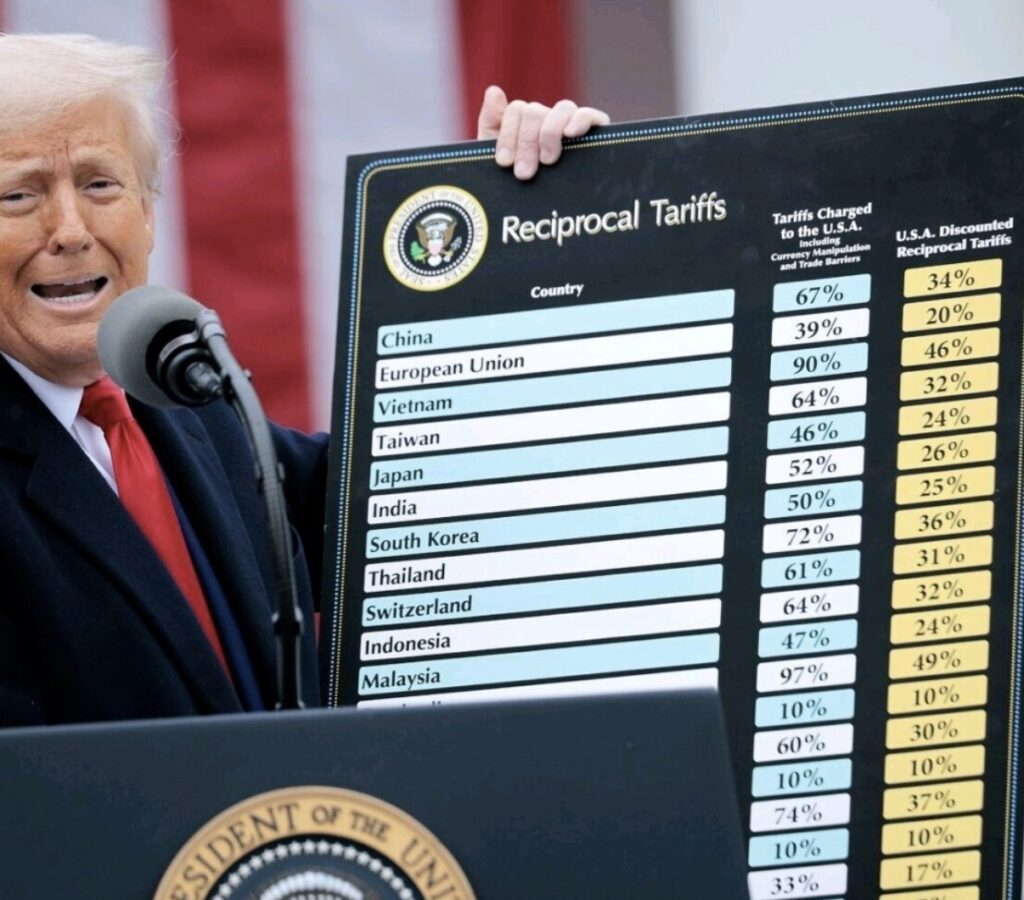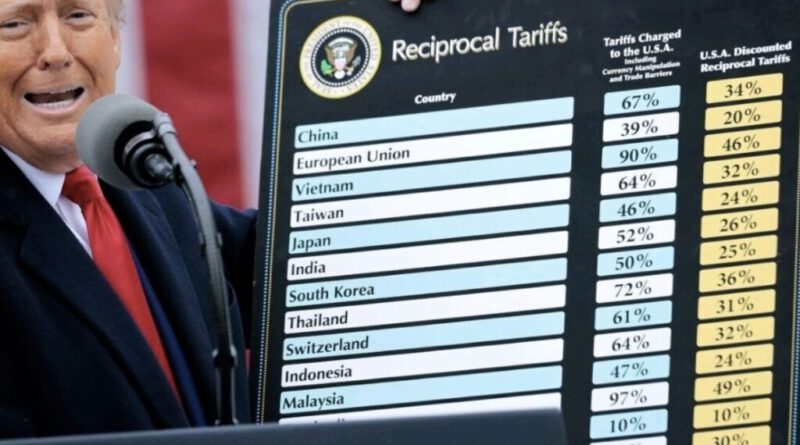What Causes America’s Trade Deficit?
Abstract: We look at Trump’s new aggressive tariff policies and the conflicting views analysts have about the economic status quo. Has China been manipulating the yuan downwards to boost exports or has the US been manipulating the Dollar upwards, by setting the CIA on any dictator who wants to divest from the Dollar? Will Trump’s tariffs reduce the US trade deficit and therefore cause capital flow out of the US, which could threaten the US Dollar global reserve currency status or do foreign investors want to invest in the US anyway? We conclude by arguing that global trade is more complicated than one may think and that multiple seemingly opposing forces contribute to America’s trade deficit at the same time.

Overview
The president of the United States has just upended global trade, with a radical and aggressive tariff policy. There is a huge amount of uncertainty and debate about the potential geo-political and economic impact of these policies, with diametrically opposing views from different camps.
Before getting into that, we just want to make clear that we believe in free markets and global trade. Trade is largely voluntary and therefore only happens when both sides of the trade believe they benefit from it. Trade is not therefore a zero sum game. There are also many legitimate reasons for persistent trade imbalances between nations. Therefore, our view is that all tariffs are bad and all reciprocal tariffs are also bad. Therefore, global growth and productivity will suffer as a result of these tariffs. Notwithstanding this, there are still massive disagreements about how international trade imbalances work, what causes them and what the impact of these tariffs could be on capital flow. That is the focus of this article.
The Trump View
In Trump’s eyes, America has been screwed over big time by its trading partners for decades and America’s giant trade deficits are proof of that. These trade deficits are the result of the protectionist policies of some of America’s largest trading partners, such as China, the European Union and Japan. The formula that Trump has used to calculate the “reciprocal tariffs”, indicates that Trump’s view is that there is no legitimate reason for a persistent trade deficit, it’s all caused by protectionism.
In Trump’s view, these protectionist policies include:
- Tariffs
- Regulation favouring domestic producers
- Exporters like China, Germany and Japan manipulating their currencies downwards against the US Dollar
As a result of these policies, the American manufacturing base has been depleted, resulting in a challenging economic climate for the American worker, which forms a large part of Trump’s MAGA political base. By finally levelling the playing field, as he promised to do on the campaign trail, the American consumer will purchase more goods domestically, resulting in a boom to America’s manufacturing base and revival of the American economy.
The Petrodollar View
Many would argue that Trump’s view on trade indicates that he does not understand economics. The reality is that Americans benefit from the trade deficit. The Americans get to benefit by consuming all the goods produced by the hard working low paid Asians in China, Japan, India, Thailand, Vietnam and Korea and of course by consuming the oil produced in the Middle East (or benefiting from lower oil prices caused by production in the Middle East). The Americans win, by getting all the goods and the Asian workers lose out, by spending all day manufacturing products in tough conditions for little pay. This is essentially a trick America has successfully played on its trading partners for decades. America has somehow convinced the trade surplus nations to invest into America, keeping the Dollar strong and allowing this favourable state of affairs for America to continue. This view is almost exactly the opposite of Trump’s view, that America is the country being screwed over.
This is an unsustainable state of affairs, because the trade deficits accumulate over time. The only reason it has gone on so long is because the US Dollar is the global reserve currency. When countries export goods into the US, they then invest the cash proceeds into the US Dollar, to keep the ponzi scheme going. At some point, the accumulated imbalances will be so large, this will all fall apart and Americans will be much poorer in real terms. To avoid this fate, Americans should invest in gold and of course, Bitcoin.
The United States has engaged in several policies to try and keep the US Dollar as the global reserve currency, in order to keep this scheme going for as long as possible, some of these policies are clandestine. Examples of some of the most nefarious such policies include the following:
- Libyan leader Colonel Gaddafi was toppled and killed, because he held considerable quantities of gold and wanted to sell oil in gold, which would have undermined the reserve currency status of the US Dollar. Indeed, as a leaked email from Sidney Blumenthal to Hillary Clinton speculated in 2011, the Libyan gold policy was “one of the factors that influenced” the decision to attack Libya.
- In October 2000 Iraqi president Saddam Hussien decided to stop selling oil in US Dollars and instead sold oil in Euros. This is said to have been a key motivating factor for the US invasion of Iraq and the killing of Saddam Hussien. The concerns about weapons of mass destruction and Saddam’s despicable human rights record being a motivating factor for the invasion, was therefore a lie. It was all about oil.
- As a result of the above and other aggressive foreign policies, other oil exporters like the UAE and Saudi Arabia know that they must keep selling the oil in US Dollars and invest a significant proportion of the accumulated wealth from the oil into the US Dollar and American assets, otherwise they could face the wrath of the CIA and other parts of the American military establishment.
One can see how the above view is diametrically the opposite to Trump’s apparent view on global trade. Rather than China manipulating its currency downwards, as Trump now alleges, the US is manipulating its currency upwards and is apparently using highly nefarious tactics to do so in some circumstances.
To highlight this apparent inconsistency, Trump recently attempted to dissuade the BRICS from creating a currency to compete with the US Dollar, which would presumably, if successful, weaken the US Dollar and strengthen their own currencies. Shouldn’t Trump want that? A weaker US Dollar would boost the MAGA manufacturing base. With his latest tariff move, Trump now also seems to be accusing the BRICS of manipulating their currencies downwards, to boost their exports to the US, which seems like a somewhat inconsistent set of accusations against the BRICS. What does America want China to do, buy US treasuries or sell them? It is almost like America cannot tolerate China doing either. We do not want to single out Trump here as being the only politician seemingly confused about which direction China is manipulating their currency in, many do it from all political parties, for example Obama and Geitner. Our point is that according to the petrodollar world view, America has a policy of propping up the US Dollar and China is planning for the end of the US Dollar as the global reserve currency.
This petrodollar view on global trade is probably the most popular view amongst our audience and Bitcoiners alike. Notable analyst Luke Gromen is a key proponent of this view. According to this world view, things for the US Dollar are reaching a period of elevated uncertainty. The rise of the BRICS in particular is an increasing threat to US Dollar hegemony and the BRICS countries may gradually pivot away from the US Dollar as their main trading and global settlement currency. It is therefore likely that at some point the US Dollar’s status as the global reserve currency is undermined and the price of oil, gold and perhaps Bitcoin elevate dramatically.
If one thinks like this, the impact of Trump’s new tariff policy could be especially devastating and dangerous for America. The exporting nations would see their trade surpluses decline and they would no longer have huge piles of capital each year to invest in US government bonds and other US assets. They could then start selling their existing US assets to boost domestic consumption, to replace the lost exports to the US. This could then act as a catalyst to cause a crisis in US treasuries and undermine the almighty US Dollar.
The Capital Flow View
There is another view of trade imbalances that is rarely articulated and in our view, there is considerable merit to this point of view, alongside the petrodollar thesis. Remember economics 101, the Balance of Payments (BoP) must always balance. This is because for every buyer of the US Dollar there must always be a seller. Therefore, if a country has a trade deficit it must have a corresponding surplus in its capital account (the flow of financial assets) and vice versa. But who is to say what is driving what? It could be that hard working Chinese labourers produce high quality items that Americans really want, this then drives an American trade deficit, which then causes the American capital surplus. On the other hand, perhaps Chinese investors want exposure to America, this causes an American capital surplus, which then results in a trade deficit with China.
The argument here is more positive on the United States than the petrodollar thesis. America has the best companies, which focus more on profits and return on equity compared to the rest of the world. Corporate America is also more meritocratic than in other regions like Europe and Asia, where who you know, where you come from and perhaps your race or gender is more important. This has helped America attract the best talent in the world. America has the best and most innovative companies in the world such as Google, Microsoft, Apple, Amazon, Nvidia, Meta, Open AI, Tesla, Broadcom, VISA, Netflix etc etc. Global investors want to invest in these high quality and growth companies.
Many investors in Asia also want to get their capital out of their home countries, to protect it from seizure by the government. In contrast America, at least in theory, has a much stronger rule of law and legal investor protections. Trump’s view that Asian exporters have been manipulating their currencies downwards is therefore totally backwards, actually they have been trying to manipulate their currencies upwards and trying to stop capital flight. According to this world view, these characteristics have driven a large American capital account surplus, which has then resulted in the large trade deficits. The persistent trade deficits may therefore not be a problem, but they could be a sign of success. It just depends on what is driving what.
In our view, these economic factors are far more significant in driving the US Dollars global reserve status than American foreign policy in the Middle East for example. Killing any dictator who wants to sell oil in gold is unlikely to have that much of an impact. This is not to say we want to defend the dishonest and nefarious intentions behind US foreign policy in the Middle East. It is possible there are some people in the US security establishment who still subscribe to the petrodollar theory, even if it’s now a little outdated and irrelevant. And if that is not true, then there are plenty of other dishonest theories to point to. Besides, even if competing fiat currencies have no chance against the US Dollar, because the investment opportunities in the US are relatively so much more compelling than in the rest of the world, there is always gold to compete with. The CIA may still need to play dirty games to stop gold. And perhaps the American establishment wants global trade to happen in US Dollars not to defend the value of the Dollar, but just to give the US authorities more control and power over global affairs, enhancing their ability to block payments and freeze wealth all over the world.
If you subscribe to this view, even if you believe in the general “tariffs are always bad idea”, this new Trump policy might not immediately be totally devastating to the US Dollar’s reserve currency status. It is of course still a tax and will damage corporate America and weaken the economy, with everyone losing, but US Dollar hegemony may continue for a while.
Conclusion
The reality is that the global economy is complicated. There is validity to the petrodollar view and the trade deficit does drive the capital account surplus to some extent. On the other hand, the same situation can be looked at from multiple valid angles. It is also true to say that the capital account surplus drives the trade deficit. The driving force applies in both directions at the same time and understanding this is important to understanding global trade. When it comes to the US, both factors are highly significant and should not be overlooked by analysts. This goes some way to explaining why some politicians appear a little inconsistent about the direction in which China is manipulating its currency.
That being said, we do think the Trump view on trade is largely invalid. The tariffs are a tax on Americans and will weaken the American economy. It might be true that the American middle class has been a relative loser from globalisation, with the spoils going to the elites, but that does not mean reversing globalisation will make the American middle class the relative winner. Trump might abolish the IRS and replace income tax with tariffs and return to pre-1930s economic policy. If this happens then it’s another question, but we won’t be betting on that.
Then there is of course the conspiracy theory to talk about. Trump is announcing these tariffs to crash the economy on purpose, to drive investors into treasuries to bring down yields, so that America can refinance its debts at lower rates and delay the inevitable crisis of not being able to afford the interest payments on the debt. In our view this is possible but unlikely. Occam’s Razor may be applicable here, the simplest explanation is usually the best, Trump just loves tariffs and hew thinks tariff is “‘the most beautiful word”.
The post What Causes America’s Trade Deficit? appeared first on BitMEX Blog.
BitMEX Blog




















